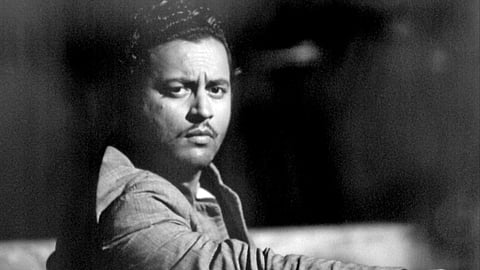
- HOMEGROWN WORLD
- #HGCREATORS
- #HGEXPLORE
- #HGVOICES
- #HGSHOP
- CAREERS
- ABOUT US
- CONTACT US

In Kaagaz Ke Phool (Paper Flowers, 1959), Guru Dutt’s final film as director, the mercurial actor, director, writer, and producer turned his lens inward, making what many saw as a cinematic portrait of his own life. His friends warned him against making the film. Even the legendary composer S.D. Burman, who scored the soundtrack, is said to have told him, “It’s just your personal life.” Dutt, however, didn’t listen. He was too close to the material — and perhaps, too compelled by the need to make meaning from personal grief and artistic disillusionment.
The first Indian film ever shot in CinemaScope, Kaagaz Ke Phool revolves around the creative journey of filmmaker Suresh Sinha, portrayed by Guru Dutt, and his relationship with newcomer Shanti (played by Waheeda Rehman), a young woman who rises to stardom with his mentorship. As Shanti’s fame grows, personal and societal pressures strain their bond, and what began as a deeply symbiotic partnership — both artistically and emotionally — begins to unravel. Over time, Suresh’s reputation crumbles; once celebrated, he becomes a figure of ridicule, dismissed as a has-been. Succumbing to alcoholism and isolation, he drifts into obscurity, eventually dying alone and forgotten by the very industry that once revered him.
Kaagaz Ke Phool was meant to be Dutt’s magnum opus — a cinematic triumph, his answer to critics of his so-called artistic eccentricities, and a Hindi film on par with Hollywood’s A Star Is Born (1937). But when it released in January 1959, the film was both a critical and commercial failure. Its reception devastated Dutt so deeply that he never directed another film again.
Although he later delivered standout performances in Chaudhvin Ka Chand (1960) and Sahib Bibi Aur Ghulam (1962), Dutt never fully recovered from the emotional toll of Kaagaz Ke Phool. Increasingly withdrawn and reliant on alcohol, he came to resemble the very character he had portrayed in Kaagaz Ke Phool. On 10 October 1964, he died alone in his rented apartment on Peddar Road in Bombay, at the age of 39. The official cause was an overdose of sleeping pills and alcohol — though whether it was accidental or intentional remains unclear.
And yet, even a century after his birth, few figures in Indian cinema inspire as much reverence — or romantic speculation — as Guru Dutt. Born Vasanth Kumar Shivashankar Padukone in 1925, his brief but incandescent career gave Indian Cinema some of its most enduring works. He is remembered today not only as a director and actor, but as a myth: the tragic genius who filmed his own heartbreak, who turned failure into beauty, and who died too soon.
But to reduce Dutt’s legacy to only melancholic auteurism is to overlook the scope of his cinematic contribution. He was a formal innovator as much as a romantic visionary — a master of mise-en-scène whose films combined stylised visual language like chiaroscuro lighting, dramatic framing, and lyrical long takes with the emotive force of mainstream Hindi cinema. His soundtracks, often created with composer S.D. Burman and lyricist Sahir Ludhianvi, were not mere interludes but emotional maps, articulating the emotional arc of his characters.
Dutt was also a collaborative powerhouse. His enduring partnership with screenwriter Abrar Alvi and cinematographer V.K. Murthy redefined the narrative and aesthetic possibilities of Hindi cinema. He helped usher in some of its most complex female characters. Sahib Bibi Aur Ghulam, though directed by Alvi, bears Dutt’s sensibility throughout. Meena Kumari’s portrayal of Chhoti Bahu — a woman spiraling into alcoholism and despair as she longs for her husband’s affection — remains one of the most layered depictions of female desire and despair in Indian film.
As an actor, Dutt’s on-screen persona was unusually introspective. He embodied a kind of masculine fragility — romantic, brooding, wounded — that stood in stark contrast to the hyper-masculine heroes of 1950s Bollywood. In death, he became a symbol: the doomed artist destroyed by his own brilliance. But that narrative, seductive as it is, can also be reductive. It obscures the structural and commercial nature of filmmaking, and the broader cinematic world that both enabled and abandoned him.
To understand Guru Dutt then is to look beyond the myth of the suffering artist — to see both the light and the wreckage he repr. He made Indian cinema more interior, more self-aware, and more emotionally ambitious. But his legacy goes beyond the nostalgia surrounding his films. It echoes in the very grammar of modern Indian filmmaking.
A nationwide retrospective of Guru Dutt's most iconic films will be held from August 8 to 10 to mark his centenary. The programme will screen newly restored editions of Dutt’s classics, including Pyaasa, Aar Paar, Chaudhvin Ka Chand, Mr. & Mrs. 55, and Baaz.
